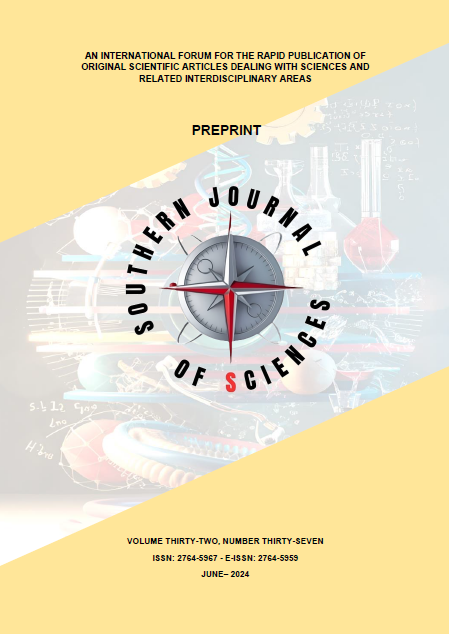INQUIRY FOR SUITABLE LOCATIONS FOR A DRILLING REGIME AT AN UPSLOPE ROCKY KNOLL OF LAWU ESTATE, WESTERN BYPASS, MINNA, NIGERIA
Background: A client requested that the study group help determine locations that would be suitable for a drilling regime at his lot, located at an upslope rocky knoll of Lawu Estate, Minna, Nigeria. Aim: The aim of this study is to carry out a purpose-specific survey to pinpoint the best locations in a built-up property at the upmarket Lawu Estate that would be suitable for a drilling regime targeted for household consumption. Methods: The study area was reconnoitered by the survey crew in order to georeference the locations that would be occupied for the vertical electrical sounding survey in the 30 m x 20 m lot. Owing to the extensive build-up at this lot, only a four-point traverse along the 30-metric dimension traverse of the frontage of the building was demarcated in the northeasterly direction, thereby limiting the desire of the survey crew to define an appropriate survey grid. The data-acquisition pattern at the 4 x 1 survey stations of the frontage-traverse of the lot followed the “traditional” sequence of Schlumberger array layout measurements, whence the survey crew progressed with current-electrode spacing either end of a survey point located at this frontage-traverse targeting a maximum survey depth of 100 m. Result: The acquired vertical electrical-sounding data set for this study was recorded on purpose-specific data sheets. Discussion: Based on empirical rules-of-thumb procedures for interpreting vertical electrical sounding data at the Nigerian Basement Complex geological province, “assured” groundwater location and “strongly aquiferous” location, deductive inferences were drawn with regards to only vertical electrical sounding Station 4. Conclusion: Thus, it is recommended that VES Station 4 be exploited in the planned drilling program of the client, especially since this survey point checks off 100 percent of the constraints imposed by the rules-of-thumb interpretation procedures.
Read ArticleFROM AIR FORCE TO HYPERSONIC FUTURE: ÉLCIO GERÔNIMO DE OLIVEIRA'S JOURNEY IN BRAZILIAN AEROSPACE DEVELOPMENT (ENGLISH VERSION)
Introdução: A entrevista com Élcio Gerônimo de Oliveira, conduzida pelo repórter Luis, apresenta a trajetória profissional de um pesquisador brasileiro com experiência na Força Aérea Brasileira e no meio acadêmico, com foco em sistemas espaciais e veículos hipersônicos. Objetivos: Documentar a carreira e contribuições de Élcio para o desenvolvimento aeroespacial brasileiro, destacando sua transição da carreira militar para a acadêmica e sua participação em projetos estratégicos, especialmente o projeto 14X. Métodos: A entrevista foi estruturada em blocos temáticos, abordando a carreira militar, a experiência acadêmica e, com maior detalhamento, o envolvimento no projeto do veículo hipersônico 14X. Foram realizadas perguntas abertas, permitindo ao entrevistado compartilhar sua experiência e conhecimento técnico. Resultados: Élcio descreveu sua progressão na Força Aérea Brasileira, desde pesquisador até vice-chefe da Diretoria de Espaço, destacando o desenvolvimento de veículos lançadores, sistemas de navegação inercial e o projeto SARA. Relatou sua transição para a carreira acadêmica, incluindo sua experiência como professor na Universidade de Luleå, na Suécia. Élcio detalhou sua coordenação no projeto 14X, um veículo hipersônico que alcançou Mach 7, com perspectivas de atingir Mach 10. Discussão: A entrevista revela a importância da cooperação internacional e da transferência de tecnologia, exemplificada pela doação do primeiro laboratório de hipersônica do Brasil. Evidencia também os desafios técnicos na construção de veículos hipersônicos e o potencial dessas tecnologias para aplicações militares e civis. Conclusão: A carreira de Élcio Gerônimo de Oliveira exemplifica a contribuição brasileira para pesquisa aeroespacial avançada, demonstrando a capacidade nacional de desenvolver tecnologias estratégicas como veículos hipersônicos, apesar das limitações de recursos, e apontando possibilidades futuras para o transporte e exploração espacial.
Read ArticleINTERVIEW WITH DEPUTY VICE CHANCELLOR DR. O. A. OMOTESHO, UNIVERSITY OF ILORIN, NIGERIA (ENGLISH VERSION)
Background: The University of Ilorin, founded in 1975 in Nigeria, has evolved from 3 to 16 faculties, becoming the country's most sought-after institution for the past two decades. Aims: To document the institutional evolution, identify the most demanded programs, assess scientific output, examine internationalization strategies, and understand strategic development objectives. Methods: Structured interview with Vice-Chancellor Dr. Olubumi Abayomi Omotesho, following a standardized protocol covering historical, academic, scientific, and strategic aspects of the institution, under Creative Commons license format. Results: The university expanded to 16 faculties in 49 years. The most demanded programs are Medicine and Nursing, followed by Pharmacy, Law, Engineering, and Accounting. Areas with the highest scientific output: Medicine, Biological/Agricultural Sciences, and Engineering. It offers 340 postgraduate programs with approximately 7,523 students. There is a dedicated infrastructure for internationalization, with plans for international accommodations. Discussion: The predominance of healthcare courses reflects global employability trends. Research aligned with Sustainable Development Goals demonstrates a contemporary vision. The institutional goal (number one in Nigeria, top 10 in Africa, top 500 globally) shows a measurable strategic approach. Commitment to internationalization aligns with global education trends. Conclusions: The institution exemplifies an evolving African university focused on academic excellence, scientific relevance, and internationalization. The prioritization of student-centered development, clear positioning goals, and international collaboration initiatives establish solid foundations for its contribution to regional and global knowledge.
Read Article